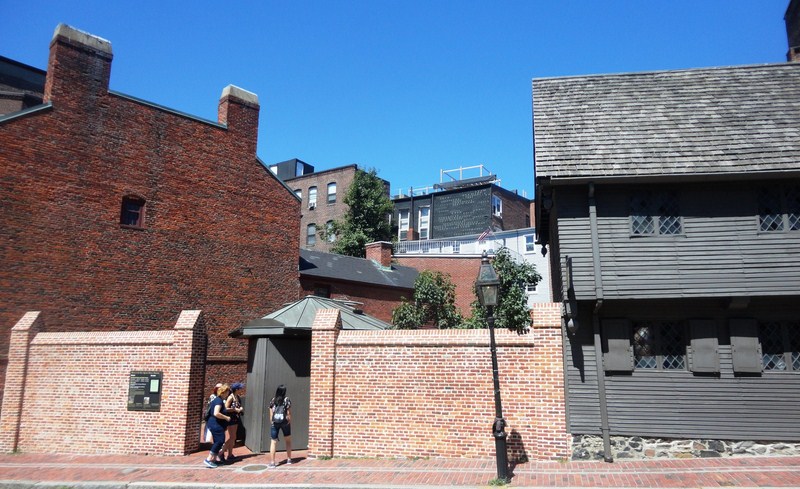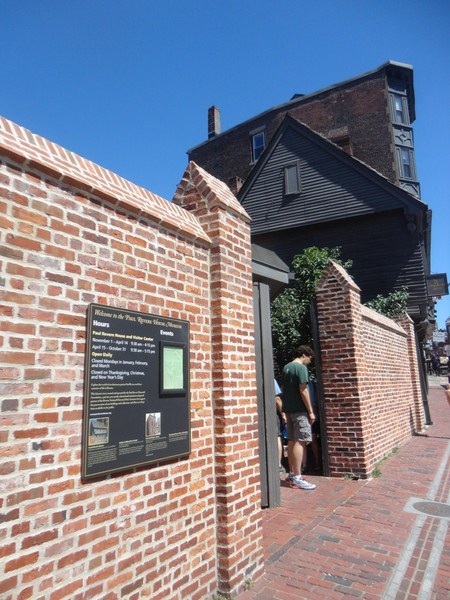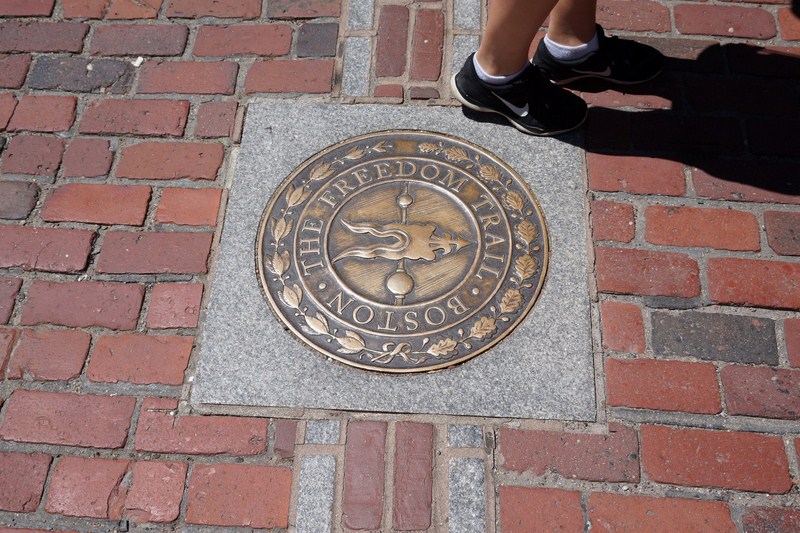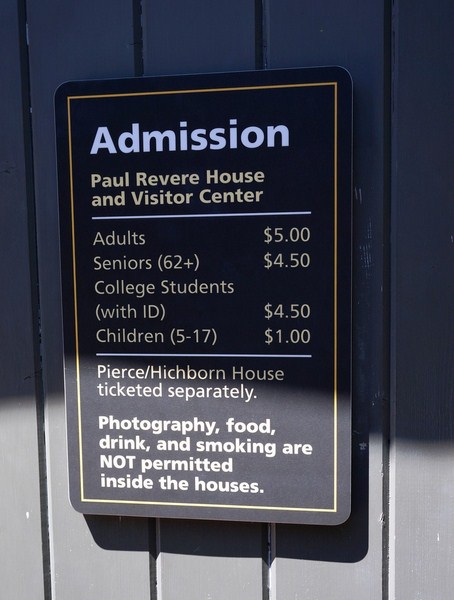The Paul Revere House, the colonial home (for about 20 years) of famous legendary American patriot, famous “Midnight Rider,” silversmith, businessman and entrepreneur Paul Revere during the time of the American Revolution, is the oldest remaining structure in downtown Boston and also the only official Freedom Trail historic site that is a home.
Check out “Freedom Trail“
It occupies the former site of the Second Church of Boston’s parsonage, home to Increase Mather and Cotton Mather, which was destroyed in the Great Fire of 1676. The original three-story house, built about 1680, was first owned by Robert Howard, a wealthy a wealthy Boston slave merchant. Howard’s L-shaped townhouse contained spacious rooms and its exterior would have been enhanced by features such as a second-floor overhang and casement windows.
From 1770 to 1800, Paul Revere owned this house. Although he and his family may have lived elsewhere for periods in the 1780s and 1790s, they lived there during the American Revolution – the most transformative and uncertain era of their generation. The rear chimney (c. 1790) including the kitchen (that visitors see in the first room they enter) were believed to have been added during the Revere occupancy.
After Revere sold the house in 1800, the home became a sailor’s boarding house for many years in the nineteenth century and, by the turn of the twentieth century, the old house had become a tenement with the ground floor remodeled for use as shops. At various times, it became a candy store, cigar factory, bank and vegetable and fruit business. In 1902, to prevent demolition, John P. Reynolds Jr. (Revere’s great-grandson) purchased the building and its restoration took place under the guidance of Joseph Everett Chandler, an architect and historic preservationist. In April 1908, the Paul Revere House opened its doors to the public as one of the earliest historic house museums in the United States.
Around the middle of the eighteenth century, the Paul Revere House went through two major and substantial renovation processes. First, to bring the house in line with the Georgian architectural style becoming prevalent at that time, the roofline facing the street was raised substantially. Second, a two-story lean-to was added in the ell between the two 17th-century portions of the house. In 1907–1908, restorers returned the roofline to its original pitch, albeit without a gable (giving rise to a commonly held misconception that the attic had been removed), and the lean-to was removed.
On January 20, 1961, it was designated as a National Historic Landmark and, on October 15, 1966, added to the National Register of Historic Places. It is now operated as a nonprofit museum by the Paul Revere Memorial Association.
The main block of the three-storey house consists of four structural bays demarcated by heavy framing posts and overhead beams, all typical of early Massachusetts Bay timber construction. Within this main block, the larger ground floor room is dominated by its chimney bay and adjoining lobby entrance. As the Revere House was set quite close to neighbors, its double casement windows were installed in the rear elevation rather than the more common placement in a gable. The two-storey extension, behind the Revere House, was unlike some contemporary Boston houses which had separate kitchen buildings. Its heavy beams, large fireplaces, and absence of interior hallways are typical of colonial living arrangements. Several pieces of furniture, believed to have belonged to the Revere family, are found at the two upstairs chambers.
Despite the renovation (which returned the house to its conjectured appearance around 1700), 90% of the structure (including two doors, three window frames, and portions of the flooring, foundation, inner wall material and raftering) is original to 1680. However, none of the window glass is original.
In December 2016, the Paul Revere Memorial Association opened, after a purchase in 2007 and US$4 million in renovations, the new, 3,500 sq. ft. Visitor and Education Center, connected to the house by an elevated walkway. For the first time, the renovations permitted wheelchair access to the second floor of the house. The education center provided additional exhibit space on Revere’s Midnight Ride, his work as a silversmith and his industrial work after the American Revolution. Classrooms and a library also allowed for expanded research and educational outreach.
Immediately adjacent and across the entry courtyard (the original site of the John Barnard House) is the brick Pierce–Hichborn House. Built about 1711 as an early Georgian house, it is also operated as a nonprofit museum by the Paul Revere Memorial Association.
Paul Revere House: 19 North Square, Boston, Massachusetts 0213. Tel: 617-523-2338. Fax: 617-523-1775. E-mail: staff@paulreverehouse.org. Website: www.paulreverehouse.org. Admission: Adults (US$5.00), Seniors and College Students (US$4.50) and Children – ages 5-17 (US$1.00). Open Daily – Summer: April 15 – October 31 (9:30 AM to 5:15 PM), Winter: November 1 – April 14 (9:30 AM to 4:15 PM). It is closed on Mondays during January, February and March as well as Thanksgiving, Christmas and New Year’s Day. The first floor of house is accessible via the courtyard ramps while the second floor is accessed by taking the elevator in the visitor center and then connecting to the house via the walkway.








Pingback: Freedom Trail (Boston, Massachusetts, U.S.A.) – B.L.A.S.T. – Live Life to the Fullest ……… Don't Stay Put